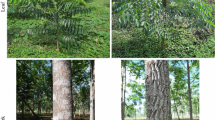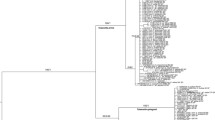Abstract
The population genetic structure of the late-stage fungus Amanita manginiana in a natural forest in Dujiangyan, southwest China was examined over two years using inter-simple sequence repeat (ISSR) markers. Seven ISSR primers were used and 170 bands were obtained in this population: 134/160 and 135/153 bands were polymorphic for sporocarps of 2001 and 2002, respectively. Each sporocarp represented a single genet in 2001 and 2002, and no identical genets were found between the two years. The results of genetic similarity comparison, using unweighted pair group method with arithmetic means, and analysis of molecular variance, indicated that although genetic variances were mainly within individuals of the same year the genetic variance between years was statistically significant (P<0.001). Relationships between genetic similarity and spatial distance of pairwise sporocarps were also found to be different in the two years. The differences in genetic structure and genetic similarity between individuals of the two years implied that the sporocarps were not likely to be derived from continuous generations, i.e., the sporocarps collected in 2002 were not developed from sexual spores dispersed by sporocarps of 2001. We suggest that the life-cycle traits of ectomycorrhizal (ECM) fungi should be considered in genetic studies on ECM fungal populations.




Similar content being viewed by others
References
Bastide PD, Kropp BR, Piché Y (1994) Spatial distribution and temporal persistence of discrete genotypes of the ectomycorrhizal fungus Laccaria bicolor (Maire) Orton. New Phytol 127:547–556
Bonello P, Bruns T, Gardes M (1998) Genetic structure of a natural population of the ectomycorrhizal fungus Suillus pungens. New Phytol 138:533–542
Dahlberg A (2001) Community ecology of ectomycorrhizal fungi: an advancing interdisciplinary field. New Phytol 150:555–562
Dahlberg A, Stenlid J (1990) Population structure and dynamics in Suillus bovines as indicated by spatial distribution of fungal clones. New Phytol 115:487–493
Danell E, Camacho FJ (1997) Successful cultivation of the golden chanterelle. Nature 385:303
Deacon JW, Fleming LV (1992) Interactions of ectomycorrhizal fungi. In: Allen MF (ed) Mycorrhizal functioning: an integrative plant-fungal process. Chapman and Hall, New York, pp 249–300
Doudrick RL, Raffle VL, Nelson CD, Furnier GR (1995) Genetic analysis of homokaryons from a basidiome of Laccaria bicolor using random amplified polymorphic DNA (RAPD) markers. Mycol Res 99:1361–1366
Excoffier L (1993) Analysis of molecular variance (AMOVA) ver 1.55. Genetics and Biometry Laboratory, University of Geneva, Switzerland
Excoffier L, Smouse PE, Quattro JM (1992) Analysis of molecular variance inferred from metric distances among DNA haplotypes: applications to human mitochondrial DNA restriction data. Genetics 131:479–491
Fiore-Donno AM, Martin F (2001) Populations of ectomycorrhizal Laccaria amethystine and Xerocomus spp. show contrasting colonization patterns in a mixed forest. New Phytol 152:533–542
Frankland JC (1998) Fungal succession—unraveling the unpredictable. Mycol Res 102:1–15
Gong M-Q, Wang F-Z, Chen Y (1994) Advances of ectomycorrhizal research for Eucalyptus. Acta Pedol Sin 31[Suppl]:127–133
Guo LD, Hyde KD, Liew ECY (2000) Identification of endophytic fungi from Livistona chinensis based on morphology and rDNA sequences. New Phytol 147:617–630
Harley JL (1991) Introduction: the state of the art. In: Norris JR, Read DJ, Varma AK (eds) Methods in microbiology, vol 23. Techniques for the study of mycorrhiza. Academic press, London, pp 1–23
Jacobson KM, Miller OK, Turner BJ (1993) Randomly amplified polymorphic DNA markers are superior to somatic incompatibility test for discrimination genotypes in natural populations of ectomycorrhizal fungus Suillus granulats. Proc Natl Acad Sci USA 90:9159–9163
Junghans DT, Gomes EA, Guimarăes WV, Barros EG, Araújo EF (1998) Genetic diversity of the ectomycorrhizal fungus Pisolithus tinctorius based on RAPD-PCR analysis. Mycorrhiza 7:243–248
Lanfranco L, Perotto S, Bonfante P (1998) Applications of PCR for studying biodiversity of mycorrhizal fungi. In: Bridge PD, Arora DK, Reddy CA, Elander RP (eds) Applications of PCR in Mycology. CAB International, Wallingford, pp 107–124
Longato S, Bonfante P (1997) Molecular identification of mycorrhizal fungi by direct amplification of microsatellite regions. Mycol Res 101:425–432
Malajczuk N, Grove TS, Bougher NL, Dell B, Gong M-Q (1994) Ectomycorrhizas and nutrients: their importance to Eucalyptus in China. In: Brown AG (ed) Australian tree species research in China. ACIAR proceedings, no. 48. Canberra, pp 132–139
Martin F, Costa G, Delaruelle C, Diez J (1997) Genomic fingerprinting of ectomycorrhizal fungi by microsatellite-primed PCR. In: Varma A (ed) Mycorrhizal manual. Springer, Berlin Heidelberg New York, pp 463–474
Molina R, Massicotte H, Trappe JM (1992) Specificity phenomena in mycorrhizal symbioses: community-ecological consequences and practical implications. In: Allen MF (ed), Mycorrhizal functioning: an integrative plant-fungal process. Chapman and Hall, New York, pp 357–423
Read DJ (1991) Mycorrhizas in ecosystems. Experientia 47:376–391
Read DJ (1997) Mycorrhizal fungi—the ties that bind. Nature 388:517–518
Redecker D, Szaro TM, Bowman RJ, Bruns TD (2001) Small genets of Lactarius xanthogalactus, Russula cremoricolor and Amanita francheti in late-stage ectomycorrhizal successions. Mol Ecol 10:1025–1034
Rohlf FJ (1997) NTSYS-pc, version 2.02. Exeter Software, Applied Biostatistics Inc.
Sawyer NA, Chambers SM, Cairney JWG (1999) Molecular investigation of genet distribution and genetic variation of Cortinarius rotundisporus in eastern Australian sclerophyll forests. New Phytol 142:561–568
Simard SW, Perry DA, Jones MD, Myrold DD, Durall DM, Molina R (1997) Net transfer of carbon between ectomycorrhizal tree species in the field. Nature 388:579–582
Simard SW, Jones MD, Durall DM (2002) Carbon and nutrient fluxes within and between mycorrhizal plants. In: van der Heijden MGA, Sanders IR (eds) Mycorrhizal ecology. Springer, Berlin Heidelberg New York, pp 34–74
Timonen S, Tammi H, Sen R (1997) Outcome of interactions between genets of two Suillus spp. and different Pinus sylvestris genotype combinations: identity and distribution of ectomycorrhizas and effects on early seedling growth in N-limited nursery soil. New Phytol 137:691–702
Watling R (1997) The business of fructification. Nature 385:299–300
Wurzburger N, Bidartondo MI, Bledsoe CS (2001) Characterization of Pinus ecotmycorrhizas from mixed conifer and pygmy forests using morphotyping and molecular methods. Can J Bot 79:1211–1216
Zhang F-M, Ge S (2002) Data analysis in population genetics. I. Analysis of RAPD data with AMOVA. Biodiv Sci 10:438–444
Zhou ZH, Miwa M, Hogetsu T (1999) Analysis of genetic structures of a Suillus grevillei population in a Larix kaempferi stand by polymorphism of inter-simple sequence of repeat (ISSR). New Phytol 144:55–63
Zhou ZH, Miwa M, Hogetsu T (2000) Genet distribution of ectomycorrhizal fungus Suillus grevillei populations in two Larix kaempferi stands over two years. J Plant Res 113:365–374
Zhou ZH, Miwa M, Hogetsu T (2001) Polymorphism of simple sequence repeats reveals gene flow within and between ectomycorrhizal Suillus grevillei populations. New Phytol 149:339–348
Acknowledgements
This work was supported by the State Key Basic Research and Development Plan of China Grant (2002CB111505 and G2000046802), National Natural Science Foundation of China Grant (30070018), and Chinese Academy of Sciences Grant (KSCX2-SW-101C). We are grateful to the Southwest Subalpine Botanical Garden, Chinese Academy of Sciences for providing climate data for the study site and to Dr. Xianming Gao, Dr. Canran Liu, and Dr. Xiaojun Du for providing information on the species composition of the study site. We appreciate comments and suggestions by Professor John Cairney, Professor Andrew Smith and two anonymous reviewers on an earlier version of the manuscript.
Author information
Authors and Affiliations
Corresponding author
Rights and permissions
About this article
Cite this article
Liang, Y., Guo, Ld. & Ma, Kp. Population genetic structure of an ectomycorrhizal fungus Amanita manginiana in a subtropical forest over two years. Mycorrhiza 15, 137–142 (2005). https://doi.org/10.1007/s00572-004-0311-8
Received:
Accepted:
Published:
Issue Date:
DOI: https://doi.org/10.1007/s00572-004-0311-8




